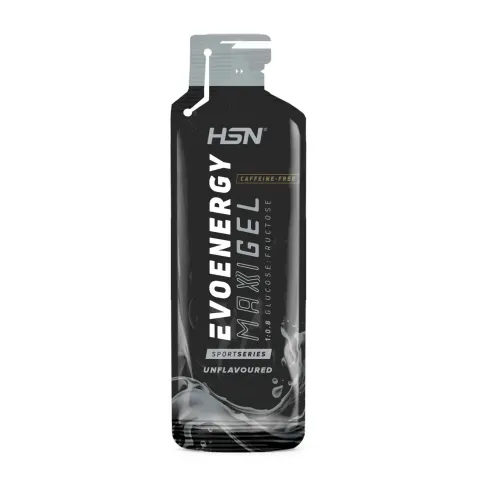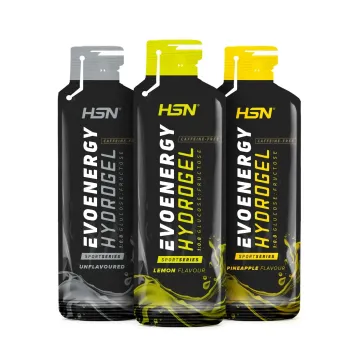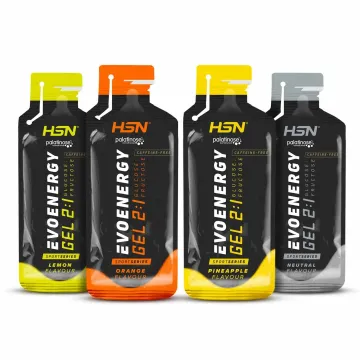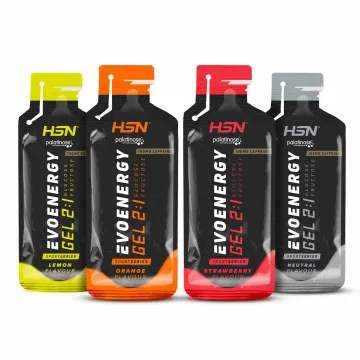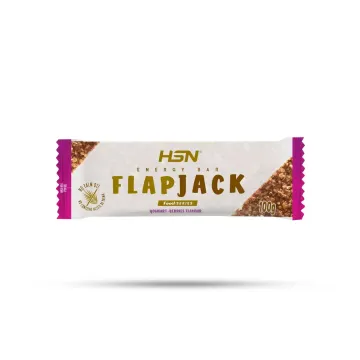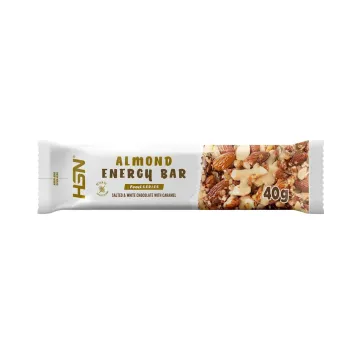- New Evoenergy Gel in Maxi version - With 40% more content than the original Evoenergy Gel.
- Available in various flavours. Delicious and balanced, for every taste.
- Smooth texture, fluid consistency - A balance between 'hydro' and traditional gels.
- With the most studied sugar ratio for sports performance - 1 Glucose (from maltodextrin) : 0.8 Fructose.
- Not overly sweet - Easy to take without needing to complement with water.
- Packaging with a strip connecting the sachet and opening.
Evoenergy MaxiGel (Caffeine-Free) - An improved version of Evoenergy Gel
Evoenergy Maxigel Caffeine-Free from SportSeries is a new gel available in HSN's catalogue, presented as an improved version of the traditional and successful Evoenergy Gel Caffeine-Free: with larger size, a more fluid texture without being hydro, and a new sugar ratio in its composition. Available in various flavours.
With a 70ml size, they are the perfect option for longer and more intense events, as a single gel provides 240 kilocalories exclusively from carbohydrates (complex + simple: maltodextrin + fructose). It also provides an ideal sodium content of around 120mg to complement the use of a usual isotonic drink during a long-duration event, or as the sole support of carbohydrates and electrolytes in short-medium duration events.
Enjoy the new Evoenergy Maxigel Caffeine-Free in your endurance training and competitions. Say goodbye to fatigue from low energy availability!
A new gel - How to incorporate it into your routine?
Evoenergy Maxigel vs Evoenergy Gel
Evoenergy Maxigel is a renewed and improved version of our classic Evoenergy Gel, but its launch does not mean that Evoenergy Gel is no longer a viable option for certain types of events and training as it remains as effective as ever, an essential product for our endurance customers.
Evoenergy Maxigel was born from the need to provide more energy for those who engage in long-duration sports activities, such as events of half marathon distance or longer, and who prefer to take fewer units of traditional gels, spacing out their intake over several kilometres, in favour of using one gel that provides more energy.
Both options are perfect for endurance events, and while we present the 'Maxigels' as an improved version, they are simply better options for those who prefer gels with more content, as Maxigel provides 70ml, which is 40% more gel than the traditional Evoenergy Gel version.
Consistency - The perfect balance between Hydro and concentration
Regarding the density of the gel, we have opted to slightly change it in our Evoenergy Maxigel, by making it lighter compared to the consistency of Evoenergy Gel.
If you are a regular user of our gels and try the Maxi version, you will notice that the texture is lighter, much more fluid, but not a hydrogel. Many people prefer lighter consistencies because they are more comfortable to take, do not have an intense taste typical of a high solute concentration, and can be taken without additional water.
However, many other users prefer more concentrated gels, with a denser consistency and higher carbohydrate content per unit, such as our original Evoenergy Gel, although this means that using them with water is highly recommended.
If you are looking for a larger gel with a lighter density, without being a hydrogel, Evoenergy Maxigel is perfect for you.
With a carbohydrate ratio studied by top international experts
Many athletes are concerned not only about the total amount of carbohydrates in the gels they consume but also about the ratio between them, as various studies support and experts advocate different carbohydrate ratios.
There is no superior carbohydrate ratio as long as we stay within studied ranges. However, due to the use of our Maxigels, we have chosen the best sugar ratio:
According to Jeukendrup, likely the leading current expert in peri-training nutrition for endurance sports, carbohydrate ratios between 1:0.8 and 2:1 are suitable for intake during sessions, with the 1:0.8 ratio being the most appropriate when higher carbohydrate amounts are consumed, closer to 120g of carbohydrates per hour of physical exercise, while for lower intakes, between 60 and 90g, all types of ratios are suitable, even those more concentrated in glucose.
Evoenergy Maxigel is the perfect gel for athletes who consume high amounts of carbohydrates during their training and competitions, with an ideal sugar ratio for optimal nutrition.
Sodium: the key electrolyte, why not others?
The composition of sweat is primarily sodium, which is the essential electrolyte for maintaining blood osmolality and pressure. Our original Evoenergy Gels contain other electrolytes like potassium and vitamin C, but after reviewing the latest scientific literature, we concluded that adding sodium chloride is the best way to maintain osmolal balance during physical exercise, especially when gels are complemented with an isotonic drink like Evocarbs 2.0, which also contains other electrolytes.
Caffeine-Free version - When it's better
As with the original Evoenergy Gels, there are caffeine and caffeine-free versions of Maxigels. The key is when to use the different types:
- If you are sensitive to stimulants, always use the caffeine-free version of the gels.
- If you have a good tolerance to stimulants, use a combination of caffeine and caffeine-free versions; limiting the use of caffeine gels to the first few kilometres of the event or just before physical or psychological 'walls' in longer events.
The caffeine-free version is ideal as a base. Whenever in doubt about whether to use a caffeine gel or not, choose the caffeine-free version as it is more versatile and applicable to most situations, especially for those with low stimulant tolerance.
Balanced flavours - Not overly sweet
With the carbohydrate content of the gels, we have not added sweeteners to their composition.
The result is a sweet, balanced flavour, ideal for taking Evoenergy Maxigel without needing to drink water simultaneously, without causing dry mouth, and without the drawbacks of excessive sweetness found in many other energy gels on the market.
Replenish energy in a balanced way with HSN gels.
How to combine it with your usual isotonic drink
Gels, even in their Maxi version, are additions, not substitutes for isotonic drinks, which should be considered the base of intra-training and intra-competition nutrition for athletes.
It is possible to use gels as a substitute for isotonic drinks in short-duration and high-intensity events, as a way to provide a large amount of quick energy, not as a means of rehydration, as isotonic drinks are used in longer events.
Using gels with an isotonic drink is simple, just consume them flexibly to provide a complementary amount of carbohydrates and electrolytes to those provided by the drink. If you aim to consume 120g of carbohydrates per hour, but hydration needs make it impractical to achieve this solely with a carbohydrate drink, gels are an excellent way to achieve it.
Can I take it before or after events?
Yes.
Gels are typically used during long-duration endurance events to prevent fatigue and increase exercise capacity by providing carbohydrates.
However, taking gels before events is an excellent strategy to provide energy nutrients that will be used during the session, and consuming them after the event helps to replenish lost glycogen and restore normal sodium levels after events with significant sweating.
Bibliographical references
- Naderi, A., Gobbi, N., Ali, A., Berjisian, E., Hamidvand, A., Forbes, S. C., … Saunders, B. (2023). Carbohydrates and Endurance Exercise: A Narrative Review of a Food First Approach. Nutrients, 15(6).
- Saunders, M. J., Luden, N. D., & Herrick, J. E. (2007). Consumption of an oral carbohydrate-protein gel improves cycling endurance and prevents postexercise muscle damage. Journal of Strength and Conditioning Research, 21(3), 678–684.
- Podlogar, T., & Wallis, G. A. (2022). New Horizons in Carbohydrate Research and Application for Endurance Athletes. Sports Medicine, 52(Suppl 1), 5–23.
- Patterson, S. D., & Gray, S. C. (2007). Carbohydrate-gel supplementation and endurance performance during intermittent high-intensity shuttle running. International Journal of Sport Nutrition and Exercise Metabolism, 17(5), 445–455.
- Kozlowski, K. F., Ferrentino-Depriest, A., & Cerny, F. (2021). Effects of Energy Gel Ingestion on Blood Glucose, Lactate, and Performance Measures During Prolonged Cycling. Journal of Strength and Conditioning Research, 35(11), 3111–3119.
- Naderi, A., Gobbi, N., Ali, A., Berjisian, E., Hamidvand, A., Forbes, S. C., … Saunders, B. (2023). Carbohydrates and Endurance Exercise: A Narrative Review of a Food First Approach. Nutrients, 15(6).
- Phillips, S. M., Turner, A. P., Sanderson, M. F., Sproule, J., & Ward, S. A. (2012). Carbohydrate gel ingestion significantly improves the intermittent endurance capacity, but not sprint performance, of adolescent team games players during a simulated team games protocol. European Journal of Applied Physiology, 112(3), 1133–1141.
- Vitale, K., & Getzin, A. (2019). Nutrition and supplement update for the endurance athlete: Review and recommendations. Nutrients, 11(6).
 Before
Before After
After During
During Morning
Morning Afternoon
Afternoon Night
Night Before
Before After
After During
During Morning
Morning Afternoon
Afternoon Night
Night Before
Before After
After During
During Morning
Morning Afternoon
Afternoon Night
Night







